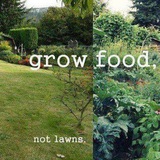It's spring, and I am honing my observational skills and planning my garden, and I want to share some tips for building these skills in a way that lends itself to practicing permaculture.
When building an ecological mindset, it's essential to start with the practice of simple observation, noticing the plants and animals without making any assumptions or judgements about how the land came to be. It takes a lot of practice, but from then on you can start formulating questions that will lead to a greater understanding of how the land around you is or wants to be.
OBSERVE THE EDGES: If you look at the edge of your yard, or the edge of a sidewalk, you may notice a greater abundance of growth. The edges between biomes are often the most biodiverse because it effectively doubles the amount of species present, but even the edge between grass and concrete, or rocks and flowers, gives a lot of insight into where plants like to grow - is the shade cooling the plants? Is there a dip in the landscaping where water is pooling? Are rocks bolstering the insect population in the area?
OBSERVE THE PIONEER PLANTS: Although "weeds" such as dandelion, kochia, and mallow can and will grow in very poor soil conditions, where they accumulate is still in an indication of soil quality and water retention. If there are no pioneer plants in a given area, could the soil be too rocky? Too compacted? Too polluted?
OBSERVE THE TOPOGRAPHY: Even fairly flat stretches of land have some degree of incline and decline. Are some plants growing more successfully in low areas compared to high areas?
When building an ecological mindset, it's essential to start with the practice of simple observation, noticing the plants and animals without making any assumptions or judgements about how the land came to be. It takes a lot of practice, but from then on you can start formulating questions that will lead to a greater understanding of how the land around you is or wants to be.
OBSERVE THE EDGES: If you look at the edge of your yard, or the edge of a sidewalk, you may notice a greater abundance of growth. The edges between biomes are often the most biodiverse because it effectively doubles the amount of species present, but even the edge between grass and concrete, or rocks and flowers, gives a lot of insight into where plants like to grow - is the shade cooling the plants? Is there a dip in the landscaping where water is pooling? Are rocks bolstering the insect population in the area?
OBSERVE THE PIONEER PLANTS: Although "weeds" such as dandelion, kochia, and mallow can and will grow in very poor soil conditions, where they accumulate is still in an indication of soil quality and water retention. If there are no pioneer plants in a given area, could the soil be too rocky? Too compacted? Too polluted?
OBSERVE THE TOPOGRAPHY: Even fairly flat stretches of land have some degree of incline and decline. Are some plants growing more successfully in low areas compared to high areas?
🥰10
Forwarded from Anarcho Gardening
The half moons are for retaining water on gentle slopes, with the flat side pointed uphill. The major function besides water retention is to prevent topsoil erosion by wind and water. They still need about two feet of annual rainfall and some soil fertility to work.
There's a similar method for highly degraded and hardened soil called a 'zaï hole' where one foot deep holes are bored at regular intervals and filled with compost. This, combined with shallow half moon walls built similar to the crescents pictured above provide a low-dig method with broader application and similar results.
https://en.m.wikipedia.org/wiki/Za%C3%AF
There's a similar method for highly degraded and hardened soil called a 'zaï hole' where one foot deep holes are bored at regular intervals and filled with compost. This, combined with shallow half moon walls built similar to the crescents pictured above provide a low-dig method with broader application and similar results.
https://en.m.wikipedia.org/wiki/Za%C3%AF
Wikipedia
Zaï
Traditional farming technique
❤2
Forwarded from Political memes
BREAKING: In a historic shift, the U.S. moves to reclassify marijuana as a less dangerous drug, AP sources say.
https://apnews.com/article/marijuana-biden-dea-criminal-justice-pot-f833a8dae6ceb31a8658a5d65832a3b8
https://apnews.com/article/marijuana-biden-dea-criminal-justice-pot-f833a8dae6ceb31a8658a5d65832a3b8
AP News
US poised to ease restrictions on marijuana in historic shift, but it'll remain controlled substance
The U.S. Drug Enforcement Administration will move to reclassify marijuana as a less dangerous drug, a historic shift to generations of American drug policy that could have wide ripple effects across the country.
🎉14
I don't know what's with people thinking trains are full of drugs and criminals. There's...security guards on trains.
And like, I HAVE seen people using meth in big train stations and sometimes there are weird people on busses but. They're not doing drugs on the bus. They're not actually bothering anyone
Sometimes you just gotta learn how to deal with strange people
And like, I HAVE seen people using meth in big train stations and sometimes there are weird people on busses but. They're not doing drugs on the bus. They're not actually bothering anyone
Sometimes you just gotta learn how to deal with strange people
👍7💯5
Forwarded from Acaposting :3 (Aca Baka @acaposting)
Aight since I'm getting ads here now just to be clear I will not be taking any of the revenue from them as I can't control what's posted here and u have to be level 50 to turn ads off and I'm not gonna ask y'all to boost the channel it's dumb as hell
👍18
